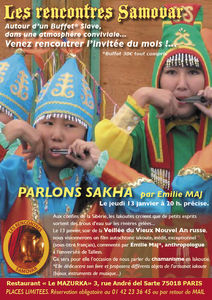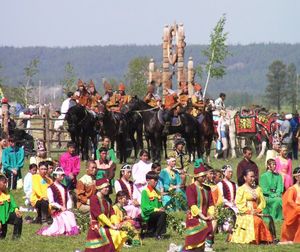 Course description
Course description
OBJECT : Anthropology of Shamanism and Possession
To introduce students to relationship between shamanism and possession and to the problem of “trance” during the ritual
|
Subject code WNT6217
|
Subject
|
Load 3 CP/ ECTS 4,5
|
Approximate load of contact hours: 20
|
|
|
|
.
|
|
|
|
|
|
|
|
|
|
|
|
|
|
|
|
|
|
|
|
|
|
|
|
|
In his Shamanism: Archaic Techniques of Ecstasy, Mircea Eliade rehabilitated Shamanism as a religion and gave to the shaman a greater value than as the possessed. Indeed, for him the shaman was the “master” of the spirit, when the possessed had a passive relation to spirits. Through cases study, the seminar will examine the differences between shamanism and possession, two kinds of relationship with spirits. We will analyze possession as a peripheral phenomenon (which develop parallel to great religions) and shamanism as religion in the center of the society. Both of them implied a role of the body and the soul and are qualified as “ecstatic”. That is why this study needs a comparison of the behavior of the shaman and the possessed, the role of the space (notion of travel) as well as of the music, dance and other elements during the ritual.
Bibliography:
Boddy, J. (1994). "Spirit Possession Revisited - Beyond Instrumentality." Annual Review of Anthropology 23: 407-434. (I have it)
Eliade, Mircéa (1951)-1968. Le chamanisme et les techniques archaïques de l’extase, Payot, 405p. (English tran, Eliade, M. (1972). Shamanism: Archaic Techniques of Ecstasy (W.R. Trask, Trans.). Princeton, NJ : Princeton University Presse (I have the French version. English version is in the Academic Library)
Eliade, Mircea 1961. Recent Works on Shamanism. A Review Article, in History of Religions(1/1), The University of Chicago Press, pp. 152-186 (I have it)
Hamayon, Roberte 1993. Are “Trance”, “Ecstasy” and Similar Concepts Appropriate in the Study of Shamanism? Szeged. Shaman I(2), 3-25. (I have it)
Hoppál, Mihály 2007. Shamans and traditions, Akademiai Kiado [Bibliotheca shamanistica 13]
Laufer, Berthold 1917. Origin of the Word Shaman, in American Anthropologist, New Series (19/3), pp. 361-371
Lewis, Ioan M. 1971. Ecstatic Religions. An Anthropological Study of Spirit Possession and Shamanism. Baltimore, Schapera, Penguin Books, 221p. (2nd ed. 1989).
Pentikäinen Juha. 1997 Shamanism and culture, Helsinki : Etnika
Pittin, R. (1996). Possession and dispossession: Changing symbolic structures and meanings in contemporary Nigeria. The Politics of Cultural Performance. D. Parkin, L. Caplan and H. Fisher. Providence, RI, Berghahn: 199-216.
Rouget, Gilbert. 1980. La musique et la transe, Paris, Gallimard, 2° ed. 1990
Sharp, L. A. (1993). The possessed and the dispossessed: spirits, identity, and power in a Madagascar migrant town. Berkeley, University of California Press (I have it or in http://www.escholarship.org/editions/view?docId=ft6t1nb4hz&chunk.id=text)
Taussig Michael, Shamanism, Colonialism, and the Wild Man. A Study in Terror and Healing, Chicago et Londres, The University of Chicago Press, 1987
Wafer James William. 1991. The Taste of Blood: Spirit Possession in Brazilian Candomble, Philadelphia, University of Pennsylvania Press
Wilson, Peter J. 1967. Status Ambiguity and Spirit Possession, Man, New Series (2/3), pp. 366-378

/https%3A%2F%2Fprofilepics.canalblog.com%2Fprofilepics%2F3%2F7%2F370605.jpg)










/https%3A%2F%2Fstorage.canalblog.com%2F88%2F41%2F430207%2F28893325_o.jpg)
/https%3A%2F%2Fstorage.canalblog.com%2F59%2F74%2F430207%2F27918713_o.jpg)
/https%3A%2F%2Fstorage.canalblog.com%2F49%2F03%2F430207%2F23462557_o.jpg)
/https%3A%2F%2Fstorage.canalblog.com%2F52%2F16%2F430207%2F23154986_o.jpg)
/https%3A%2F%2Fstorage.canalblog.com%2F89%2F16%2F430207%2F22957762_o.jpg)